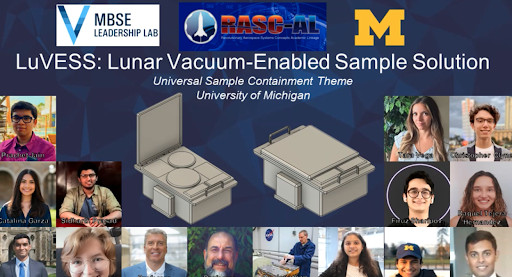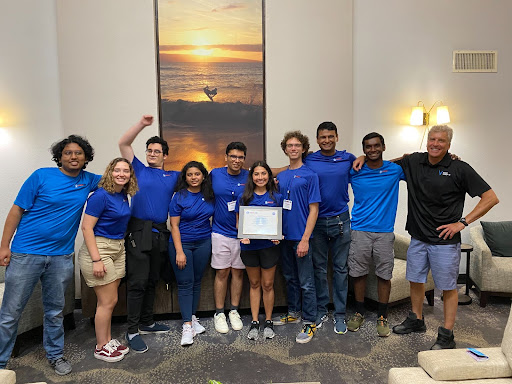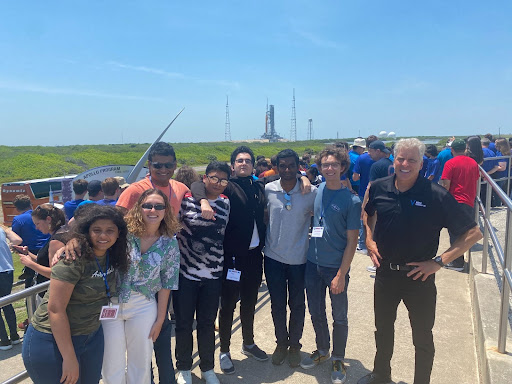
Going to the moon: Aero students win NASA competition for their sample containment system design
U-M RASC-AL team shares their experience on the design process, competition challenges, and beach volleyball

U-M RASC-AL team shares their experience on the design process, competition challenges, and beach volleyball
Students in Aerospace 495 Systems Engineering develop a design concept from start to finish. Some are involved in student teams, and some identify a design challenge and rise to the occasion. One group of students formed a team to compete in NASA’s annual Revolutionary Aerospace Systems Concepts – Academic Linkage (RASC-AL) Competition. The team created a LuVESS: a Lunar Vacuum-Enabled Sample Solution and competed in one of the four RASC-AL categories this year. They won.
We met up with them once they returned, victorious, to Ann Arbor. Here’s what they had to say.

What was this competition and how did you get involved?
RASC-AL is a space mission concept design competition. Every year, themes are released for next-generation concepts which university teams are asked to investigate and propose design concepts. The themes are released in late summer, and a proposal is due in early March that details requirements, sound engineering behind the design, and the design itself at a somewhat high level. A few teams per theme are then invited to the conference to present their concepts based on the merits of the proposal.
AE495 provided the opportunity for us to initially enter this competition. It was a unique opportunity, as this is the first time in the course’s history that the curriculum could be proven with a space mission design project.
What was the most challenging part of preparing for the competition?
The most challenging part of this competition was preparing for questions and defending our design choices. With our design reviews as part of the 495 class, we experienced scrutiny at levels many of us hadn’t expected. This prepared us and even made us over cautious at times for what the judges may ask. The practice runs went on much longer than planned as we would ask each other questions that only someone with a fine tooth comb would bring up. Thus, through our design reviews, we found ourselves well prepared for the competition.
What was it like to win??
After being selected as a finalist, we really did aim to win at the conference. This having been the first time a U-M team has competed in over a decade, we worked hard to make sure we were putting our best foot forward. Winning in our design category was an awesome reward for our efforts, and enticed all of us to carry forward the knowledge we acquired from this competition to continue participating with excellence in years to come.
What was the process?
We entered the competition early in the F21 semester, and integrated our team into the AE495 course. From four design themes put forward by RASC-AL, we selected the universal sample return for manned lunar missions theme. Our work from selection to the end of the fall semester involved getting ready for the AE495 Preliminary Design Review. We worked hard to define the concept as best we could, but had an admittedly difficult design review. The judges present really helped us refocus and map out a solution to completing the project.
After personnel changes early in the W22 semester, we put our noses to the grindstone to prepare a technical proposal for the March 1 deadline, plus a Critical Design Review in early February. We took judge commentary to heart, and with the help of our technical advisors ironed out much of the technical kinks in our solution. Even though our design was at a high level, we really focused on making sure our systems engineering–requirements definition, mapping design choices to those requirements, and defending them with research and analysis–was spotless. We submitted a proposal and short video by March 1, and were notified of our selection as finalists a month later.
We continued refining the design and worked on a prototype to bring to the competition. We submitted our technical paper–the meat of the deliverables on which we would be judged–by May 30, after reviews from our advisors. We arrived at the forum in the wee hours of the morning on June 20th after harrowing flight delays and cancellations. We presented slides, a poster, and our prototype and faced questioning from judges at the Forum. We were also able to see presentations from teams across the country and network with industry professionals.

Talk about your team and how you balance engineering, operations and planning?
Our team is chartered fundamentally on values of open communication, personal accountability and responsibility, and excellence in engineering. Within this, we apply systems engineering principles to our team structure. We divided our small team of 11 into disciplines of systems engineering, risk management, and technical groups (structures, cryo, controls/power). Operations and planning falls within the systems engineering discipline and with the senior management (team captain).
What surprised you the most as you prepared and competed this year?
Perhaps the most surprising aspect of the competition was just how technically adept all the teams we competed against were. Given the exclusivity of the competition’s finalists, we expected the incoming teams to have some innovative designs, but we were still pleasantly surprised at the depth and innovation displayed by the designs across the four themes. Given that this was the first time a team from U-M had competed in the RASC-AL competition in more than a decade, our high expectations from the competition were surpassed by the technical excellence of the teams in the competition.
What set your team apart from other competitors?
Our use of systems engineering, commercially off the shelf technology, and the attention to detail set our team apart from the others. As part of the 495 class, we were expected to develop our own requirements considering the theme announcement from RASC-AL, direction from judges and technical advisors, and any NASA information about the Artemis missions. Throughout the design review cycle that all 495 groups participated in, we refined the scope of the project and revised requirements to ensure that our design was as realistic as possible. Additionally, we utilized commercially available technology with heritage as much as possible. This enabled the design to be built in a shorter period of time and at a lower cost. Lastly, our design went into great detail from the cooling mechanisms down to the nuts and bolts; each chosen considering environmental conditions, power constraints, and astronaut dexterity.
What role do your mentors and advisors play in helping the team?
Our mentors and advisors played a crucial role in our success in this project. With a project of this complexity, most of us did not even know where to begin the design process. The technical advice and guidance we received from our advisors was instrumental in helping us carry out our design process. Their experience and technical knowledge helped us navigate the challenges presented by this project in order to come up with a winning design. Through periodic design reviews, our mentors helped us refine our design while preparing us for the questions asked by the panel of judges at the competition. Perhaps most importantly, our advisors offered us support and encouragement, and ensured that our team worked together to deliver a competitive design to the competition.
How does participating in RASC-AL compliment what you are learning in the classroom?
Projects like RASC-AL help us apply what we learn in the classroom to a real-world project. For example, our project utilized systems engineering practices we learned in the aero curriculum through AEROSP 495 to develop our design, which was something the RASC-AL judges particularly liked.
Generally, being able to apply classroom instruction to a real-world project improved our abilities as engineers and exposed us to the intricacies of engineering that cannot be experienced through traditional classroom-based teaching.
What are your summers like when you have a big competition like this? Can you still pursue internships and other summer opportunities?
Many of us are doing research, internships, and even working full-time. While we may have been scattered in different states and countries, we continued to work through the summer on weekends and virtually. When it came time to travel to Florida, the majority of us were able to get time off for the competition.
What do you do for fun?
We all were fortunate to attend this conference located at an ocean-front resort. Part of the RASC-AL competition was a beach volleyball tournament, which we spent our down-time practicing for. Despite our win in the design competition, we were eliminated in the first round of beach volleyball despite our best efforts. We also enjoyed playing games and swimming in the ocean during the conference, and bonding activities like this really helped us grow as a team.

What’s next for RASC-AL?
While this win essentially marks the end of our participation in this year’s competition, we are excited to make participation in this competition a lasting activity within Aero. New design themes will be released in late July, and we are exploring ways to set up a lasting infrastructure for this team to exist, transferring knowledge and lessons learned.